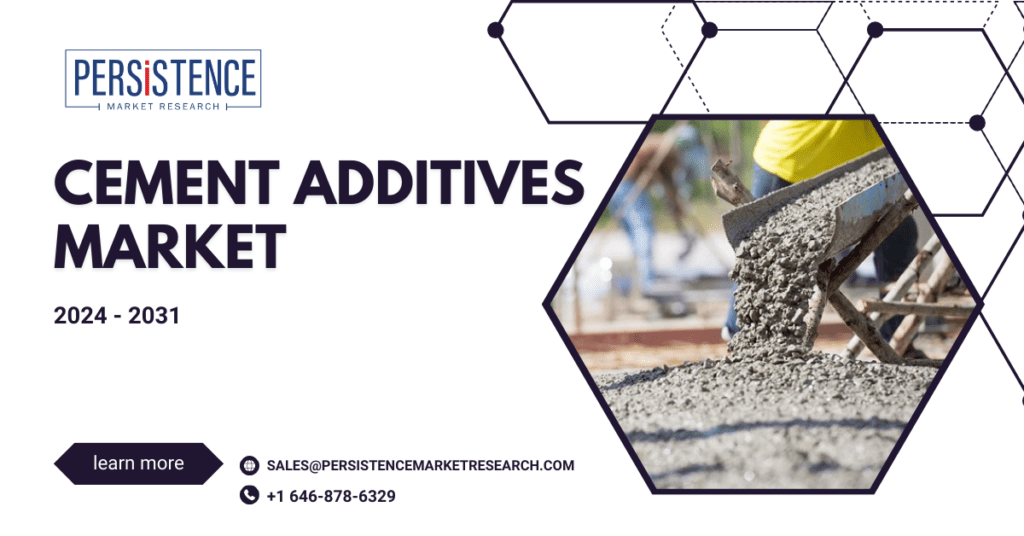
Cement additives are integral to modern construction, offering enhanced performance and durability for concrete. While their primary function is to improve concrete properties, the economic benefits of using these additives are substantial and multifaceted. This article explores the economic advantages of incorporating cement additives, including cost savings, increased efficiency, extended service life, and overall value enhancement in construction projects.
For More Industry Insight: https://www.persistencemarketresearch.com/market-research/cement-additives-market.asp
1. Reducing Overall Construction Costs
One of the most significant economic benefits of using cement additives is the potential for cost savings throughout the construction process.
- Material Efficiency: Cement additives such as superplasticizers allow for a reduction in the water-cement ratio while maintaining workability. This leads to stronger concrete, which can reduce the quantity of cement required. For instance, high-performance concrete (HPC) formulated with additives can achieve desired strengths with lower cement content, leading to cost savings on raw materials.
- Reduced Labor Costs: Additives such as retarders and accelerators help control the setting time of concrete, making it easier to manage large-scale pours and complex construction schedules. This flexibility can reduce labor costs by minimizing delays and optimizing workforce utilization. For example, accelerators enable faster curing, allowing for quicker progress and reducing the overall project timeline.
- Lower Transportation Costs: The use of additives that improve concrete properties can lead to fewer structural elements being required. For example, high-strength concrete allows for thinner and lighter structural components, which can reduce transportation and handling costs. By optimizing the design and reducing the need for excessive material, overall transportation expenses can be lowered.
2. Enhancing Concrete Durability and Longevity
Cement additives contribute to the long-term durability and longevity of concrete structures, which translates into significant economic benefits over time.
- Reduced Maintenance and Repair Costs: Concrete enhanced with additives such as air-entraining agents and corrosion inhibitors exhibits improved resistance to environmental factors and chemical attacks. This increased durability reduces the frequency and cost of maintenance and repairs. For example, concrete with high resistance to freeze-thaw cycles and chemical attacks will have a longer service life, minimizing the need for costly repairs and replacements.
- Extended Service Life: The use of high-performance and durable concrete can extend the service life of structures, leading to cost savings over the long term. Structures that resist deterioration and damage will require fewer repairs and replacements, resulting in lower lifecycle costs. For instance, infrastructure projects such as bridges and highways benefit from the extended service life provided by durable concrete, reducing the need for costly rehabilitations.
3. Improving Construction Efficiency
Cement additives enhance the efficiency of construction processes, leading to both time and cost savings.
- Faster Construction Cycles: Additives such as accelerators and superplasticizers enable faster setting and curing times for concrete. This accelerates construction schedules, allowing for quicker project completion and reduced time on site. The ability to complete projects more quickly translates into cost savings and improved resource utilization.
- Enhanced Workability: Additives that improve workability, such as superplasticizers, make it easier to place and finish concrete. This enhanced workability reduces the need for extensive manual labor and specialized equipment, resulting in lower labor and equipment costs. Improved workability also ensures better-quality finishes and reduced waste, contributing to overall cost savings.
- Optimized Formwork and Reinforcement: Concrete mixtures with additives that enhance strength and durability can lead to more efficient use of formwork and reinforcement materials. For example, high-strength concrete allows for the design of more slender and efficient structural elements, reducing the amount of formwork and reinforcement required. This optimization can result in cost savings on materials and construction processes.
4. Enhancing Sustainability and Environmental Benefits
The use of cement additives can contribute to more sustainable and environmentally friendly construction practices, which can have economic advantages.
- Reduced Environmental Impact: Cement additives that incorporate industrial by-products, such as fly ash or slag, help reduce the environmental impact of concrete production. By utilizing these by-products, the demand for virgin raw materials is decreased, leading to lower energy consumption and reduced greenhouse gas emissions. Sustainable construction practices can also result in cost savings through regulatory incentives and certifications.
- Green Building Certifications: Incorporating sustainable cement additives can contribute to achieving green building certifications, such as LEED (Leadership in Energy and Environmental Design). These certifications can enhance the marketability of a project and potentially lead to financial incentives, such as tax credits or reduced operating costs. Additionally, green building practices can attract environmentally conscious clients and investors.
- Lifecycle Cost Savings: Sustainable concrete solutions, including those enhanced with additives, often result in lower lifecycle costs. Structures that are designed to be more durable and energy-efficient require less maintenance and operational expenses. This can lead to significant cost savings over the lifespan of the building or infrastructure.
5. Increasing Property Value
The economic benefits of using cement additives extend to the increased value of properties and infrastructure.
- Enhanced Aesthetics and Quality: Additives that improve concrete properties can lead to higher-quality finishes and more aesthetically pleasing results. For example, coloring agents and polishing additives can enhance the appearance of concrete surfaces, increasing the overall value of residential and commercial properties.
- Improved Structural Performance: Concrete with enhanced strength and durability contributes to the overall performance and safety of structures. This improved performance can result in higher property values and increased marketability. For instance, commercial properties with durable and low-maintenance concrete may attract higher rental or sale prices due to their superior quality and long-term value.
- Reduced Insurance Costs: Structures with enhanced durability and resistance to damage may qualify for reduced insurance premiums. Insurance providers often offer lower rates for properties that demonstrate superior performance and lower risk of damage. The use of cement additives that improve concrete strength and durability can contribute to these cost savings.
6. Competitive Advantage and Market Differentiation
Using cement additives can provide a competitive edge and differentiate construction projects in the market.
- Innovation and Technology: Incorporating advanced cement additives showcases a commitment to innovation and technology. This can enhance the reputation of construction firms and attract clients looking for cutting-edge solutions. The use of state-of-the-art additives demonstrates a focus on quality and performance, setting projects apart from competitors.
- Customizable Solutions: Cement additives allow for customization of concrete properties to meet specific project requirements. This flexibility enables construction firms to tailor solutions to client needs, offering unique and value-added features. For example, customized concrete mixes with additives can address specific performance criteria, such as high load-bearing capacity or specialized aesthetic finishes.
- Client Satisfaction: Delivering high-quality and durable concrete solutions can lead to increased client satisfaction and repeat business. Clients are more likely to choose construction firms that provide reliable and long-lasting results, contributing to positive word-of-mouth referrals and a strong market reputation.
